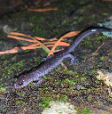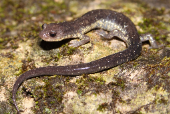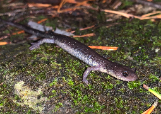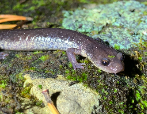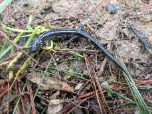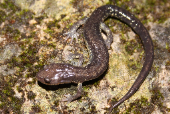Blacksburg Salamander (Plethodon jacksoni)
Description: Plethodon jacksoni is a large, slender Plethodon from the eastern United States that has a similar morphology to Plethodon wehrlei and Plethodon dixi, but has an intermediate total length of range 69 - 135 mm (average 116.1 mm) in adult males and 113 - 133 mm (average 124.6 mm) in adult females. From the dorsal view, the head shape of P. jacksoni is broadly oval with its widest point immediately posterior to its eyes. The snout is depressed and bluntly pointed. Plethodon jacksoni has 4 vomerine teeth and 6 - 7 parasphenoid teeth shared between two slender patches that are separated from the vomers approximately the diameter of the salamanderís naris. The teeth are slightly wider towards the posterior. The mental glands of the male are obvious. There are also noticeable swellings in males below each naris that projects downward. The eyes are prominent. The well-rounded body is slightly wider than tall at their largest points. Between the axilla and groin, there are 15 - 18 costal grooves in total, including the grooves in the axilla and groin, and 3 - 4 intercostal grooves.
Habitat: The Blacksburg Salamander has been found in or near caves, in rock crevices, and also on the forest floor where it resides under stones, logs and other surface cover. It shows a preference for the drier upper third of hillsides where other congeners were absent. North Carolina populations are generally associated with mesic hardwood forests and forested slopes, and often where there are rocky ledges or forest-floor habitats with numerous logs and flat rocks.
Range: This species occurs in the Montgomery, Floyd, and Carroll counties of Virginia, and Alleghany county, North Carolina, USA. Due to the continuing uncertainty regarding the taxonomy of this concept, and therefore the limits of its distribution, the species has been mapped to the counties for which records have been assigned to it.
Found in these States:
NC |
VA
Diet: This salamander forages at night within low vegetation for ants, mites, spiders, beetles, and other terrestrial invertebrates.
Reproduction: Females presumably oviposit in deep underground cavities since eggs of this and other members of the P. wehrlei complex have never been found on the ground surface.
Status: Listed as Data Deficient in view of continuing uncertainties as to its extent of occurrence, population status, ecological requirements, and threats. It has only very recently been removed from synonymy and its distribution is not well known, and the population status and threats are not known.
»» Kingdom: Animalia - Animals
»» Phylum: Chordata - Chordates
»» Subphylum: Vertebrata - Vertebrates
»» Class: Amphibia - (Amphibians)
»» Order: Caudata - Salamanders
»» Family: Plethodontidae - Lungless Salamanders
»» Subfamily: Plethodontinae - Plethodontinae Salamanders
»» Genus: Plethodon
»» Species: Plethodon jacksoni - Blacksburg Salamander
This article uses material from the Wikipedia article "Blacksburg Salamander", which is released under the Creative Commons Attribution-Share-Alike License 3.0. Content may have been omitted from the original, but no content has been changed or extended.
|


